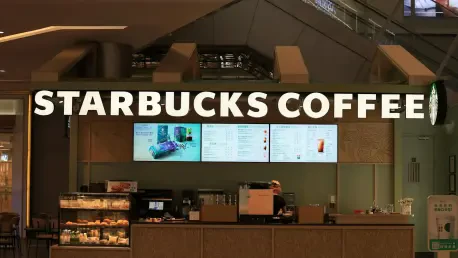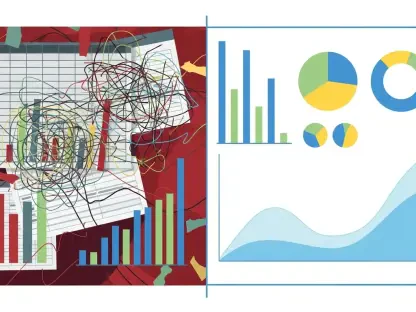Starbucks, the global coffee powerhouse, finds itself navigating turbulent waters as recent financial reports paint a concerning picture of declining performance in key markets, raising questions about its future. In the fiscal third quarter, global comparable-store sales dipped by 2%, marking the sixth consecutive quarter of decline and signaling persistent challenges in maintaining customer traffic, particularly in North America where a 3% drop was recorded. While overall revenue climbed 4% to $9.5 billion, fueled largely by new store openings, this growth masks deeper issues of profitability that have left investors questioning the sustainability of the current trajectory. However, not all news is grim—China, a vital market, reported a 2% increase in same-store sales, driven by higher customer visits. This mixed bag of results raises a critical question about whether Starbucks can orchestrate a recovery or if the ongoing slump will continue to weigh heavily on its future prospects.
Revamping Operations for a Comeback
Enhancing Service and Customer Engagement
Starbucks is not standing still amid its sales challenges, instead rolling out ambitious initiatives to revitalize its brand and reconnect with customers. Central to this effort is the Green Apron Service model, a system designed to standardize operations and elevate the customer experience. Pilot stores testing this model have already shown promising results, with noticeable improvements in transaction volumes, sales figures, and service speed. This approach, set to expand to all U.S. company-owned stores by mid-August, reflects a strategic focus on consistency and quality. Beyond service, Starbucks is introducing fresh menu items like protein cold foam and coconut-water-based beverages to spark interest and encourage higher spending per visit. These moves aim to address the root causes of declining traffic by making each store visit more appealing and efficient, potentially turning casual customers into loyal patrons.
The scope of Starbucks’ revitalization extends beyond service protocols to include significant technological and physical upgrades. Investments in mobile app enhancements and streamlined ordering systems are geared toward meeting modern consumer expectations for convenience and speed. At the same time, new store designs and remodels are being implemented to create a more inviting atmosphere, hoping to draw customers back into physical locations despite the broader trend of declining in-store traffic. Each remodel, while costly, is a calculated bet on long-term customer retention. These efforts collectively represent a multi-pronged strategy to modernize the Starbucks experience, addressing both operational inefficiencies and evolving market demands. If successful, this could lay the groundwork for a sustained recovery, though the immediate financial burden of these changes remains a pressing concern for stakeholders monitoring the balance between investment and return.
Innovating to Drive Growth
Another layer of Starbucks’ turnaround plan focuses on product innovation as a catalyst for growth in a competitive market. The introduction of unique offerings, such as baked goods and specialty drinks, is intended to differentiate the brand and attract a broader customer base. These new items are not just about variety but are strategically priced to increase the average ticket per visit, a metric that has shown a modest 1% uptick globally despite overall traffic declines. This approach seeks to maximize revenue from existing customers while enticing new ones with fresh reasons to choose Starbucks over competitors. The emphasis on innovation underscores a recognition that standing still is not an option in an industry where consumer preferences shift rapidly.
Complementing product innovation is a broader push to strengthen digital engagement, recognizing the growing importance of online platforms in driving sales. Upgrades to the mobile app and ordering system are designed to make transactions seamless, catering to a demographic that values speed and accessibility. This digital focus is paired with targeted marketing campaigns to highlight new menu items and seasonal offerings, aiming to create buzz and drive foot traffic. Additionally, loyalty programs are being refined to reward frequent customers, fostering a sense of connection with the brand. While these initiatives show early signs of traction, their success hinges on consistent execution across diverse markets. The challenge lies in ensuring that these digital and product innovations translate into tangible sales growth without further straining financial resources already stretched thin by other turnaround costs.
Financial Pressures and Future Outlook
Navigating the Cost of Change
The financial implications of Starbucks’ turnaround strategy are substantial, casting a shadow over the short-term outlook despite the promise of long-term gains. Store remodels, averaging around $150,000 per location, represent a significant capital outlay, while an additional $500 million in annual labor costs is being allocated to improve the guest experience through enhanced staffing. These investments have taken a toll on profitability, with adjusted operating margins shrinking to 10.1% in the second quarter and store operating expenses rising to 45.9% of sales. The impact is starkly evident in earnings, with adjusted earnings per share dropping 46% to $0.50, falling short of analyst expectations. This financial strain highlights the delicate balance between investing in growth and maintaining fiscal health, a challenge that Starbucks must address to reassure investors.
Beyond the immediate costs, the broader financial landscape reveals additional hurdles for Starbucks as it seeks stability. The 4% revenue increase to $9.5 billion, while positive, is largely attributed to new store openings rather than organic growth from existing locations, underscoring the persistent weakness in same-store sales. This reliance on expansion rather than core performance raises questions about sustainability, especially as operating costs continue to climb. Leadership is exploring cost-reduction measures to offset these expenses, though specifics remain unclear, adding an element of uncertainty to the recovery timeline. For now, the focus remains on whether these heavy investments will yield the anticipated uptick in customer traffic and sales, or if they risk further compressing margins without delivering proportional returns in the near term.
Leadership’s Vision for Recovery
Under the guidance of CEO Brian Niccol, Starbucks is charting a course toward recovery with an eye on historical benchmarks for profitability. Niccol has expressed confidence in returning to pre-pandemic operating margins, using 2019 as a reference point, and even surpassing those levels over time. This optimism is rooted in a belief that strategic investments in service, innovation, and store enhancements will drive customer loyalty and sales growth. However, achieving this vision requires not just revenue increases but also rigorous cost management, an area where concrete plans are still under development. The leadership’s focus on balancing short-term financial pain with long-term gains is critical, as any misstep could prolong the current downturn and erode investor confidence.
The path forward also involves strategic adjustments in key markets to optimize performance. In China, for instance, where a 2% same-store sales increase offers a bright spot, Starbucks is considering partnerships while maintaining a significant stake to leverage local expertise without sacrificing control. This pragmatic approach reflects a broader intent to tailor strategies to regional dynamics, ensuring that global initiatives are adapted to local consumer behaviors. While leadership’s aspirations are ambitious, the timeline for margin recovery remains uncertain, especially given the ongoing sales slump in North America. Stakeholders are keenly watching whether these strategic maneuvers, paired with a renewed focus on operational efficiency, will translate into measurable financial improvement over the coming quarters.
Investment Considerations and Market Sentiment
Evaluating Stock Valuation Risks
From an investment perspective, Starbucks presents a complex proposition as the company balances early signs of recovery against significant financial risks. The stock’s forward price-to-earnings ratio of 32 for fiscal 2026 indicates a premium valuation, suggesting that the market has already priced in expectations of a turnaround. However, with same-store sales continuing to decline in critical regions like North America, and profitability taking a hit from high turnaround costs, there is substantial uncertainty about whether these expectations are realistic. Investors must weigh the potential for growth against the possibility that recovery may take longer than anticipated, especially if customer traffic fails to rebound as planned. This dynamic has led to a cautious stance among many market observers.
Further complicating the investment outlook is the competitive landscape in which Starbucks operates. The coffee and quick-service restaurant sector is crowded with players vying for consumer attention, often through aggressive pricing or innovative offerings that challenge Starbucks’ market share. While the company’s brand strength and global presence provide a buffer, the persistent sales declines signal vulnerabilities that competitors could exploit. For now, the high valuation combined with operational challenges suggests that the stock may not offer a compelling entry point for risk-averse investors. The key will be monitoring whether upcoming quarters show sustained improvement in same-store sales, as this metric will likely serve as a litmus test for the effectiveness of current strategies and their impact on financial health.
Gauging Potential for Long-Term Gains
Despite the immediate hurdles, there are elements of Starbucks’ strategy that hint at long-term potential for those willing to weather short-term volatility. The positive results from pilot programs like the Green Apron Service model, coupled with growth in markets such as China, suggest that the groundwork for a turnaround is being laid. If these initiatives scale successfully across the global network, they could restore customer confidence and drive consistent sales growth. Additionally, the focus on digital innovation positions Starbucks to capitalize on evolving consumer habits, particularly among younger demographics that prioritize convenience. These factors provide a case for optimism, though they must be viewed against the backdrop of current financial pressures that could delay progress.
Looking back, the journey Starbucks embarked on reveals a company determined to address its challenges head-on, even at significant cost. The heavy investments made in operational standardization, store upgrades, and product innovation were bold steps taken to reverse declining trends. Leadership’s commitment to surpassing historical profitability levels was evident, though tempered by the reality of squeezed margins and earnings shortfalls. As a next step, close attention should be paid to whether same-store sales stabilize in the coming quarters, as this will signal the true effectiveness of the turnaround plan. For investors, staying informed about cost management strategies and regional performance will be crucial in assessing whether the stock can deliver on its long-term promise without succumbing to near-term risks.









